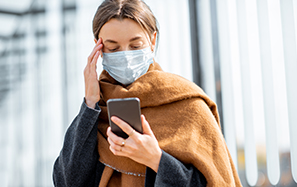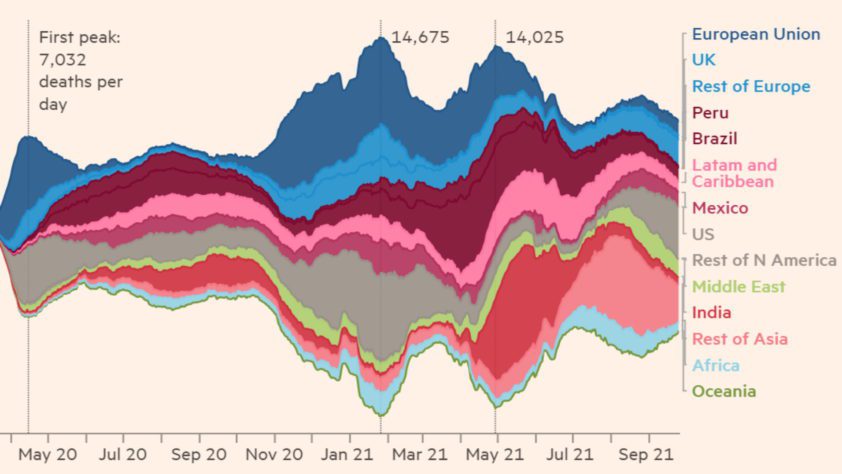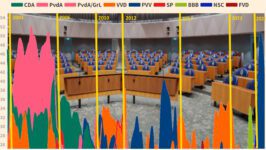It was already clear that the amount of virus particles (virions) inhaled, determines whether you are infected or not. In the meantime, it is possible to specify this even more. On the one hand it concerns the number of virions in the air and how long this is inhaled. On the other hand, it concerns parameters such as age, whether or not you have been infected before, if you have been vaccinated and when. This article provides insight into this through numerical examples, which can also explain all kinds of patterns of the spread of Covid-19. Take note: this article is only a hypothesis
Lees volledig artikel: How to explain the transmission patterns of Covid-19
How can all the patterns be explained?
Time and time again we see that when a country experiences a sharp increase in positive Covid-19 tests, it is followed by a sharp decrease. And there are many claims as to why this happens: “The success of the measures”, “immunity”, “change of season”, “ivermectin”. The past six months, the “vaccination percentage” was added to this.
And when I look at the pre-determined expectations, I often get the feeling that nobody really knows. And if you believed like the WHO and RIVM (CDC in the Netherlands) for the longest time (and with regard to the RIVM still believe) that most contamination happen via larger drops, why should you value the analysis of the cause of decreases (or increases)?
There are two reasons why I was already interested in airborne transmission from early on:
1 – “trying to find a logical explanation of the transmission pattern at the time” and
2 – “scientific studies, dealing with the spread of SARS 1 and influenza”. Based on new studies, this quickly moved from a hypothesis/assumption to a certainty.
Similar
There is another topic where something similar occurs. When I look at all kinds of transmission patterns of the virus all over the world, and over time, I miss a logical universal explanation for it. Now, I do not want to claim to have such an explanation. So, please consider everything you read below to be a hypothesis. So, it is an assumption, which aims to look further and see to what extent that statement can be maintained or should be rejected.
That is why I feel it is important to share it with you. It is thus very important to understand:
- It is a hypothesis/assumption.
- And it concerns averages, not separate individual cases. The situations can be specific for each separate individual and can deviate (significantly) from the averages.
The subject is: Being infected with the Covid19 virus. And it explains all transmission patterns that we see.
The viral dose
Recently, Prof. Streeck once again came with a special study about the major outbreak on 15 February 2020 in Gangelt (across the Dutch border in Germany).
The infection (of almost half of the 450 people present during a carnival) happened via virus particles in the air that was inhaled by those present. The thorough study has shown, among other things, that the longer people were present in the room, the greater the chance that they had become infected. And the older they were, the higher the probability that they were infected.
The two elements support my description of how infection proceeds on an individual level and the patterns established globally. See this study from August also further supports this. And the higher the inhaled doses of the virus, the higher the chance of getting infected.
Virions
The number of Covid-19 virions that are inhaled play a key role in this. A virion is a Covid-19 virus particle, which is approximately one hundredth micrometer big (1 divided by a hundred million. So, if you portray the virion as 1 centimeter in size, an average human being on the same scale is 17 kilometers tall). The number of virus particles that an infected person has in his body is estimated at 1 billion to 100 billion. While the weight remains only 0.1 milligrams. This is also explained further in this report. This article also concerns this subject.
In this explanation, I assume that the vast majority of infections are caused by inhaling virus particles, which then end up deep in the lungs. Gradually, people worldwide are coming to the conclusion that this is in any case the case in the vast majority of cases. Personally, I think that this figure is above 90%. (Realize that in the last century people thought that measles was spread through larger droplets, but around 1985 it was concluded that it was air-borne.)
The big question, of course, is how many Covid-19 virions do you have to inhale to get infected?
Thus, to allow the virus to spread quickly through your body, and when antibodies are built-up. This could include symptoms and sometimes such severe symptoms that you have to be admitted to hospital or could even die.
The exact marginal value cannot be determined, because it will also differ from person to person. But the average marginal value could well contain millions of virions.
For further explanation, we express the average marginal value in 10,000 virions. (In reality, that could be a factor of 100 or 1000 higher.)
The basic figures
- The impact of the number of virions on the average person
Based on research, I think this is the way it goes for the average person. (And once again: the figures are only used to assist in the process description).
- The more virions one inhale than 10,000, the greater the chance that you will get symptoms. And if it is much more, the greater the chance that you will get very sick (the latest research by Prof. Streeck demonstrated this). Let’s assume that the boundaries are as follows:
- Between 10,000 and 15,000 virions: no symptoms
- Between 15,000 and 20,000: light symptoms
- Between 20,000 and 30,000: severe symptoms
- Above 30,000 very severe symptoms.
- But there’s actually another crucial point. If you don’t pass the 10,000 virions yardstick of this study, so you don’t get infected, something still is happening inside your body. The body has some type of first reaction, which causes the marginal value required to be infected the next time to be higher than 10,000. Prof. Bouma calls this “micro-vaccination”. In New Delhi it was established in January already that more than 50% of the population had antibodies, while the outbreaks were still very limited at that time.
Marginal value
So, if the average person, who we are now talking about, inhales 5,000 virions, his marginal value will increase to, for example, 12,500. If he inhales another 5,000 virions, the marginal value increases even further. This aspect is a very important component for explaining the patterns with exponential rises first and then rapid falls! Because an always-increasing number of the population thus comes into contact with some virions, without being infected, but their marginal value increase.
(N.B. A certain nuance with regard to the number of virions also concerns whether those virions are inhaled when you are at rest or when you inhale deeply. In the latter case, it goes deeper into the lungs. I think this is partly the reason why such a high percentage of those present are always infected during outbreaks in choir.)
2. The effect of the person’s age and health on the marginal values
We can also divide the average person based on age. The older the person is, the lower the average marginal value. For example:
- Under 20 years: 25,000
- Between 20 and 40 years: 15,000
- Between 40 and 60 years: 10,000
- Between 60 and 80 years: 5,000
- Above 80 years: 2,500
The health situation of an individual and the strength of his immune system, his nutrition (think about D3) provides a higher or lower value than the average of your own age. The time of the year will also play a role. In our regions, the summer will on average lead to higher marginal values than the winter.
3. The effect of having the disease and vaccination on the marginal values
I understand that the following is a simplification. But to understand the rest, it is very important. Apart from the possible side effects of the vaccine, you could say that the marginal value of the number of virions that lead to an infection, shoots up after vaccination. So, if the marginal value of an average person is 10,000, the vaccination increases the marginal value to 20,000. (Here too, the figures are just to illustrate my point.)
Having a Covid-19 infection also leads to a sharp increase in the marginal value of an average person. On average, it appears that this is even higher than the effect of a vaccination.
This increases, regardless of the person’s age. But whether that is mainly a value (an increase by 10,000/30,000) or a relative value (an increase by a certain percentage) is unclear.
4. The transmission of virions by newly infected persons
In this model we assume that a newly infected person only transmits virions above the same 10,000 marginal value. Research has shown that there can be a big difference per individual in how many virions are released into the air. (The so-called super spreaders.)
The synthesis
In its simplicity, you can say that every person at some point has its own marginal value, which is mainly determined by the above. (Age, health situation, suffering from the infection, vaccination, and the “micro-vaccinations” and some other characteristics).
I am assuming that there are much more virions in the air than we think. In a safe area, with good ventilation, there are very little virions present. Under such conditions, you probably only inhale about 10 an hour (on the scale of 10,000).
But in a different area, where the conditions are unfavorable (for example during the carnival in Gangelt), a person would probably inhale an average of 3,000 virions per hour. This also varies based on where in the hall you are. And depending on the personal marginal values and how many virions you inhaled, will determine whether you will be infected or not and how bad the symptoms will be.
But it is crucial to realize that those present in a room where one or more people have become infected, have also inhaled virions. But apparently not enough to be infected. (So, at this carnival in Gangelt where almost half of the people were infected, the other persons present definitely also inhaled virions!)
The longer….
Thus, regardless of your own marginal value, it is clear that the more virions in the air and the longer you are present in the area, the higher the probability that you will become infected. And once you have been infected, the severity of the symptoms also increases as you inhale more virions. (This is a calculator, where you can estimate, by entering certain values, the size of the risk in the area. The site is called “safeairspaces.com”.)
This way of reasoning also shows what happens. So that vaccinated people can still get infected and their chance of getting seriously ill is a lot smaller than among the non-vaccinated. If the number of virions inhaled by the vaccinated is high enough, then a marginal value is also exceeded for them.
- This also explains that breakthrough infections (i.e., vaccinated people who nevertheless become infected) are more common in the elderly than in young people. They reach their marginal value quicker.
- If there is decreasing protection through vaccination over time, this means that the marginal values decrease again over time.
- But the virus variant also plays a role in this. We know that more virus particles are secreted in the Delta variant than in the earlier variants. (There are different calculations, but I assume a factor 4 here.) This means that with the Delta variant there are a factor of 4 more virions in the air than with the variant from March 2000.
This would explain many patterns
Let’s assume that the assumptions above are correct. It would explain many of the patterns. I call it a series:
– Seasonal effects
Depending on where in the world you are, there are seasons during which there are more virions in the indoor areas. In our regions, this is when the temperature drops below degrees and the humidity drops below 6 g/kg. And in India it is during the monsoon period. In areas where a lot of air-conditioning must be used during the summer, for example the southern states of America, the virions are also floating along for longer.
– More contagious variants
An infected person will then distribute more virions.
– The effect of the vaccination
Here are (a lot) more virions necessary to be infected. And also a higher number of virions required to make you extremely sick.
– The effect of being infected
After being infected, the marginal value increases sharply, before you get infected again.
– The reduced working of the vaccine
The marginal value of being infected, decreases over time.
– Different patterns between younger and older people
As you get older, the marginal value decreases. That thus also explains why vaccinated older persons get infected sooner than vaccinated younger persons.
– Sharp decrease that follows a sharp increase
A large part of the population then inhales smaller amounts of virions. Which means that their marginal values increase and the probability that they are then infected decreases.
– Increase in people with protection against “off-season” infection
There have been studies, such as in Japan among the employees of a large company. They showed that the proportion of employees who had antibodies increased markedly in the summer of last year, without any major outbreaks in the country. There will then be small amounts of virions in a period when the weather was most favorable to increase the marginal value.
– Major outbreaks with new variants, while a large portion seemed protected
Because the new variants ensure that significantly more virions are released into the air and the marginal values fall among the groups that were vaccinated some time ago, major outbreaks can still occur. Especially if that happens in an “unfavorable” season, when the virus is most likely to remain floating in indoor spaces for a long time.
In conclusion
Once again: this is nothing more than a strong suspicion (hypothesis). It is applicable to average situations and the situation can be different per individual. It would explain many of the patterns and it could also support a good approach, both on a collective level and on an individual level.
I’m releasing it now because it’s relevant enough to see if there’s any hard evidence that shows that it does not work this way. (The so-called falsifying of a hypothesis.) And to see how it can help us in the future. Whether that concerns Covid-19 or its successor or other viruses, especially the infections of the lower respiratory organs (the lungs).
You have just read: How to explain the transmission patterns of Covid-19.








